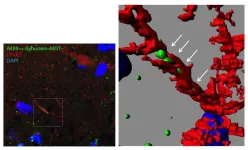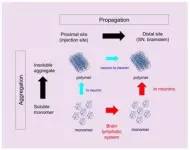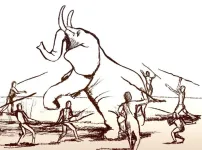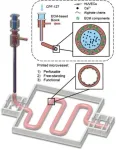(Press-News.org)
Researchers from Tokyo Medical and Dental University (TMDU) show that the protein involved in Parkinson’s disease, α-synuclein, can propagate through the lymphatic system of the brain before it aggregates
Tokyo, Japan – In many neurodegenerative disorders, abnormal proteins progressively aggregate and propagate in the brain. But what comes first, aggregation or propagation? Researchers from Japan share some new insights about the mechanism involved in Parkinson’s disease.
In a study published recently in Cell Reports, researchers from Tokyo Medical and Dental University (TMDU) have shown that a mutated version of a protein called α-synuclein propagates to various cerebral regions through the lymphatic system and then aggregates.
Although the function of α-synuclein is not fully understood, it participates in neurotransmission. However, in some neurodegenerative diseases including Parkinson’s disease, α-synuclein changes shape and forms pathological clumps.
“Most experiments conducted so far only used fibrils, which are the clumps formed when monomeric α-synuclein aggregates. The fibrils are transmitted from neurons to neurons, but it remains unclear whether monomers act in the same way,” explains Kyota Fujita, an author of the study.
To further investigate how monomers and fibrils of α-synuclein move around in the brain, the researchers injected small amounts of viral particles into the orbital cortex of mice to produce fluorescent monomeric mutant α-synuclein. Because any cell type can contribute to α-synuclein propagation, they used viral particles to enable the synthesis of α-synuclein monomers in all cell types present in the injection area. This method ensured that all modes of propagation were accounted for.
Twelve months after the injection, although the fluorescent signal was lower in the injected region, signals were detected in other brain areas. Interestingly, fluorescent α-synuclein was detected in remote regions two weeks after injection, indicating an early spreading of mutant α-synuclein in the brain.
But how did α-synuclein propagate? The team followed the three-dimensional distribution of α-synuclein in the brain and found fluorescent α-synuclein in the glymphatic system (Fig 1), which is the lymphatic system of the brain. The glymphatic system is involved in draining and renewing fluid from the brain and eliminating toxins, but it could also distribute toxic substances throughout the brain. The team also observed the presence of fluorescent α-synuclein in the matrix surrounding neurons and in the cytosol of neurons. This finding suggested that fluorescent α-synuclein was taken up by the extracellular matrix and, subsequently, by neurons.
The researchers also investigated the aggregation state of α-synuclein in the remote brain regions. “Fibrils of α-synuclein formed after the monomers had propagated,” says Professor Hitoshi Okazawa, the research group leader. “Specifically, we observed α-synuclein monomer in the glymphatic system and remote regions as early as two weeks after injection, while we found α-synuclein fibrils 12 months after injection!”
The amount of α-synuclein aggregated and the time at which they formed after injection varied among regions and was not proportional to the distance from the injection site. This observation is consistent with the known vulnerability of some regions to pathological α-synuclein.
This study shows how monomeric α-synuclein propagates through the glymphatic system in a different way from the fibrils (Fig 2). Thus, targeting these early events, α-synuclein monomer and brain lymphatic system, may limit the progression of Parkinson’s disease.
###
The article, “Mutant α-synuclein propagates via the lymphatic system of the brain in the monomeric state”, was published in Cell Reports at DOI: 10.1016/j.celrep.2023.112962
END
A new study from the Department of Archaeology at Tel Aviv University found that the extinction of large prey, upon which human nutrition had been based, compelled prehistoric humans to develop improved weapons for hunting small prey, thereby driving evolutionary adaptations. The study reviews the evolution of hunting weapons from wooden-tipped and stone-tipped spears, all the way to the sophisticated bow and arrow of a later era, correlating it with changes in prey size and human culture and physiology.
The researchers explain: "This study was designed to examine a broader unifying hypothesis, which we proposed in a previous paper published in ...
A review paper by scientists at the Chonnam National University summarized the recent research on bioprinting methods for fabricating bioengineered blood vessel models. The new review paper, published on Aug. 1 in the journal Cyborg and Bionic Systems, provided an overview on the 3D bioprinting methods for fabricating bioengineered blood vessel models and described possible advancements from tubular to vascular models.
“3D bioprinting technology provides a more precise and effective means for investigating biological processes and developing new treatments than traditional 2D cell cultures. Therefore, it is a crucial tool ...
Hyperthermia is a potentially non-invasive cancer treatment that capitalizes on the heat intolerance of cancer cells, which are more sensitive than normal cells. In order to induce effective hyperthermia, it is necessary to apply the appropriate temperature according to the cell type, i.e., to comprehensively study the thermal toxicity of the cells, which requires accurate regulation of the culture temperature. Researchers from Keio University in Japan have developed a cell culture system with temperature ...
Research Highlights:
More than half of adults (55%) with uncontrolled blood pressure who enrolled in a digital monitoring program that connected patients with clinical advice and included a bilingual app paired with at-home blood pressure monitors had controlled final blood pressure measurements after participating for least 90 days.
Patients using the Spanish-language version of the digital monitoring program demonstrated more improvement in blood pressure control than patients who used the English-language version.
Embargoed until 6:30a.m. CT/7:30 a.m. ET Thursday, Sept. 7, 2023
BOSTON, Sept. 7, 2023 — Over half of patients ...
Research Highlights:
An analysis of data from a long-running study of more than 11,000 adults from four diverse communities in the United States has found that adults who had high blood pressure while both seated upright and lying supine (flat on their backs) had a higher risk of heart disease, stroke, heart failure or premature death compared to adults without high blood pressure while upright and supine.
Adults who had high blood pressure while lying supine but not while seated upright had similar elevated risks of heart attack, stroke, ...
Research Highlights:
An analysis of electronic health records for more than 60,000 adults in the United States found that systolic, or top-number, blood pressure rose slightly during the winter compared to summer months. The health records were of adults being treated for high blood pressure from 2018 to 2023 at six health care centers of varying sizes located in the southeast and midwestern United States.
The researchers found that, on average, participants’ systolic blood pressure increased by up to 1.7 mm Hg in the winter months compared to the summer months.
They also found that population ...
Research Highlights:
Community health centers participating in the National Hypertension Control Initiative (NHCI) that introduced self-measured blood pressure interventions to their patients — including individuals from Black, Hispanic and American Indian/Alaskan Native populations, who are disproportionately impacted by hypertension and by the COVID-19 pandemic — experienced improvements in blood pressure control rates since 2021, when NHCI began.
Community Health Centers in the NHCI that received funding from the U.S. Department of Health and Human Service’s Health Resources and Services Administration and Office of Minority Health and ...
Heart problems after a COVID infection are a serious concern for both elite athletes and recreational athletes alike. A study from Amsterdam UMC, published today in Heart, offers some reassuring news. "We examined over 250 elite athletes and found that those who had contracted COVID-19 did not experience severe heart issues that impacted their careers," says Juliette van Hattum, a PhD candidate in sports cardiology at Amsterdam UMC.
The study specifically focused on elite athletes, a group that could be particularly susceptible to heart issues, particularly heart ...
Antarctica’s vast ice masses seem far away, yet they store enough water to raise global sea levels by several meters. A team of experts from European research institutes has now provided the first systematic stability inspection of the ice sheet’s current state. Their diagnosis: While they found no indication of irreversible, self-reinforcing retreat of the ice sheet in West Antarctica yet, global warming to date could already be enough to trigger the slow but certain loss of ice over the next hundreds to thousands ...
Early findings of two studies from the University of Michigan Rogel Cancer Center shed light on new ways to anticipate recurrence in HPV-positive head and neck cancer sooner. The papers, published in Cancer and Oral Oncology, offer clinical and technological perspectives on how to measure if recurrence is happening earlier than current blood tests allow, and provide a framework for a new, more sensitive blood test that could help in this monitoring.
“When metastatic head and neck cancer returns, it impacts their quality of life and can be disfiguring, interfering with the ability to talk, ...





